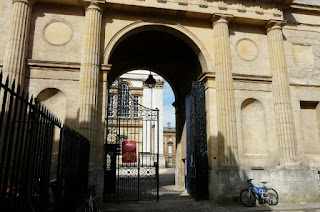"Literary Links" is a series of posts celebrating
Britain's wonderful links with great authors, dramatists and poets.
 |
| St Mary de Crypt, Gloucester |
The Church of St Mary de Crypt in Gloucester is the burial spot for James “Jemmy” Wood (1756-1836) - one of four ‘misers’ claimed
as the inspiration for Charles Dickens’ well known character Ebenezeer
Scrooge. The four skinflints are:
- Contestant number one was Gabriel de Graaf a cruel19th century gravedigger from the Netherlands who disappeared one Christmas Eve and resurfaced years later a reformed man.
- Our second contestant is the Londoner John Elwes (1714-1789) who was orphaned at an early age, and inherited around £100,000 from his father's estate. Years later his rich uncle bequeathed £350,000 to him (1763) and he acquired over 100 London properties. Despite his huge wealth he was frugal to the extreme looking more like a poverty stricken debtor than a man of means.
- The next contestant is a generous Edinburgh merchant called Ebenezer Lennox Scroggie (1792-1836). Their story goes that in 1841 Dickens was lecturing in the city and visited the Canongate Kirk graveyard where he saw Ebenezer's tomb describing him as a - "meal man" referring to his trade as a corn merchant. Dickens mistakenly read it as "mean man". Two years later (1843) Ebenezer Scroggie a "mean man" was resurrected by Dickens as Ebenezer Scrooge. This version is disputed as no more than an urban legend.
- And finally, Gloucester’s
contestant was our very own James “Jemmy” Wood (1756-1836), owner of
the Gloucester Old Bank and possibly Britain’s very first
millionaire. He is buried here in
St Mary de Crypt. He was nationally renowned for his
stinginess, and Dickens actually mentions “Jemmy Wood of Gloucester” in Our Mutual Friend.

James 'Jemmy' Wood
“Oh! But he was a tight-fisted hand at the grindstone, Scrooge! a squeezing, wrenching, grasping, scraping, clutching, covetous old sinner! Hard and sharp as flint, from which no steel had ever struck out generous fire; secret, and self-contained, and solitary as an oyster. The cold within him froze his old features, nipped his pointed nose, shrivelled his cheek, stiffened his gait; made his eyes red, his thin lips blue; and spoke out shrewdly in his grating voice. ….External heat and cold had little influence on Scrooge. No warmth could warm, no wintry weather chill him. No wind that blew was bitterer than he…”
 |
| St Mary de Crypt |
However,
our James Wood from Gloucester is also claimed to influence another of Dickens’
novels – Bleak House.
Wood’s
will was very obscure which resulted in years of legal wrangling over who was
entitled to his remaining £900,000. The
court case dragged on for so long that most of the funds disappeared in legal
fees. In the preface to Bleak House
Charles Dickens explained “At the present moment there is a suit before the
Court which was commenced nearly twenty years ago…” In
Bleak House the very first chapter introduces us to the court case of Jarndyce
vs Jarndyce which,
“…drones on. This scarecrow of a suit has, in course of time, become so complicated that no man alive knows what it means. …. Innumerable children have been born into the cause; innumerable young people have married into it; innumerable old people have died out of it. Scores of persons have deliriously found themselves made parties in Jarndyce and Jarndyce without knowing how or why; whole families have inherited legendary hatreds with the suit. The little plaintiff or defendant who was promised a new rocking-horse when Jarndyce and Jarndyce should be settled has grown up, possessed himself of a real horse, and trotted away into the other world. Fair wards of court have faded into mothers and grandmothers; a long procession of Chancellors has come in and gone out; the legion of bills in the suit have been transformed into mere bills of mortality; …but Jarndyce and Jarndyce still drags its dreary length before the court, perennially hopeless.”
This
is an excerpt from the tour Gloucester City Tour - Part Two which
explores the streets around the Cathedral. The full tour is found
on www.obelisktours.co.uk










































